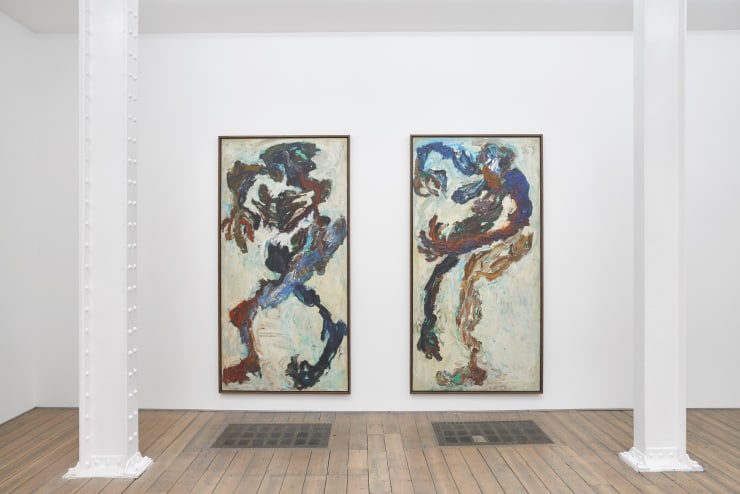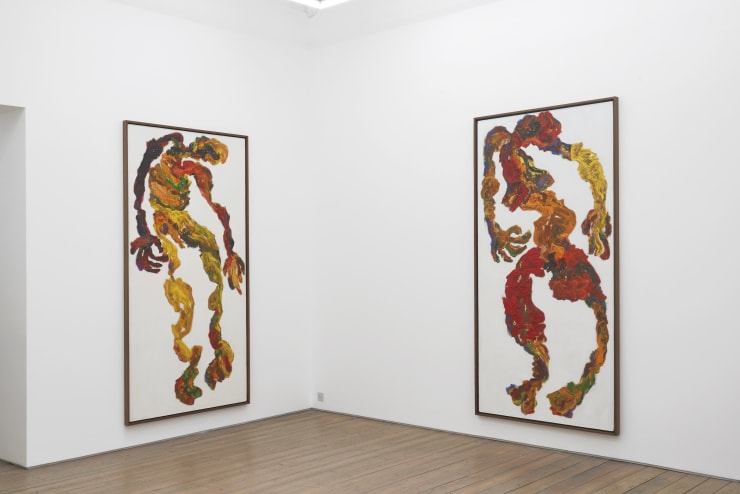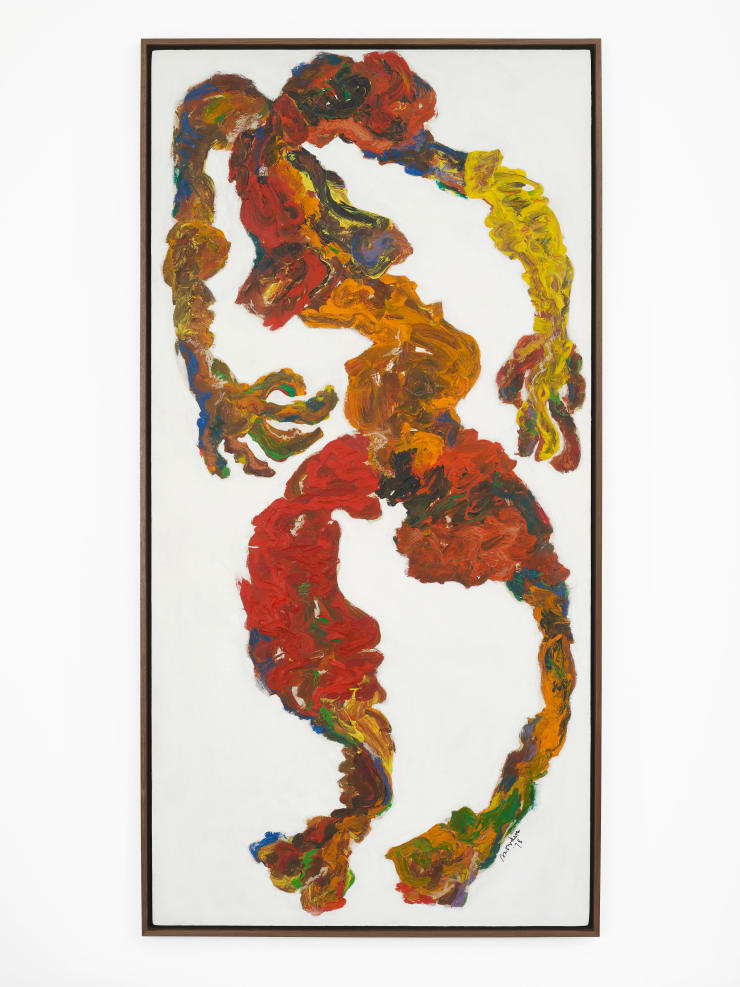Sylvia Snowden: M Street on White
Opening reception | Wednesday 13 September 6-8pm
Essay by Laura Smith, Director of Collection and Exhibitions, The Hepworth Wakefield
The human spirit is what interests me more than anything.
Colour pulsates, thumps and skids across the surfaces of the eight paintings featured in Sylvia Snowden’s new exhibition M Street on White at Edel Assanti, London. The eight twisted and distorted figures she presents are composed of turbulent, unruly, yet self-assured and dextrous brushstrokes. Snowden’s quick, heavy and vigorous gestures push and pull her paint into networks of almost recognition; her figures buckle, bend, swell and wilt in paint so thick that it almost becomes sculptural, with swathes of deep reds, verdant greens and moody blues as deep as a lip, a finger, or an eyelid.
Snowden was born in 1942 in Raleigh, North Carolina to academic, politicised parents who cultivated her artistic ideas from a young age – gifting her a set of watercolour paints when she was just four years old. She spent her childhood in the Deep South before moving to Washington DC when she was 13 years old. Snowden’s mother; Jessie Burns Snowden, had an abiding interest in art and was, as the artist remembers: ‘always dressed in wonderfully colourful clothes’ in ‘a colourful and beautiful home’ that made her ‘appreciate being surrounded by beauty’. As well as laying the foundations for Snowden’s profound understanding of colour and aesthetics, she also recalls how encouraging her parents were of her decision to be an artist: ‘Without my parents, I wouldn’t be a painter.’ They travelled to every exhibition opening she had, they bought her paint supplies, and supported her both financially and emotionally. From 1960 to 1965 Snowden undertook undergraduate and postgraduate studies in Fine Art at Howard University. Significantly, her artistic training coincided with a pivotal moment in Black American political history and the ongoing civil rights struggle, and she became deeply invested in these contentions. In 1964 she also studied for a summer at Skowhegan School of Painting and Sculpture in Maine, where she experienced a radical pedagogy that encouraged abstract experimentation.
In the late 1970s, following a divorce but with her artistic career blossoming, Snowden needed to find a home that was big enough to house a studio, as well as being affordable and habitable for her and her two children. She describes walking around the then run-down Shaw area of Washington DC with her young son and finding the house on M Street that she still lives in today. Snowden was only ever concerned with two things – her children and her painting – and this house, though semi-dilapidated (she has lovingly renovated it over the years) allowed her to look after these dual concerns under one roof. (Though she remembers fondly when, sometime later, the same son asked her: ‘Ma – are we gonna ever live in a normal house?’) The house, and importantly the street, became enduring sources of inspiration. It was here that she created her M Street series, portraying the resilience of her neighbours, an inner city, lower-income community of ‘proud young girls, worn-out women, and jobless men who formed the daily parade outside her window’. Each work in the M Street series – typically paintings of lone figures with misshapen bodies, outsized extremities and vibrant clashes of colour – is named after someone who Snowden knew from the neighbourhood.
These powerful paintings condense the psychological essence of her subjects: their triumphs, torment, joy and pain are described in thick impasto. However, outside of her titular use of the place and person’s names, Snowden removes all narrative. These are not traditional portraits of her subjects – rather, through abstraction and improvisation, she seeks to create a psychological human connection between herself, her subject and her viewers: ‘I see things in other people that are reflected in me.’
The emotional intensity of her paintings is deliberate and purposeful. Her unruly distortions, extraordinary chromatic decisions and spatial disorientation mean that limbs are atrophied or swollen, woefully enlarged or cripplingly slight. Her figures are not recognisable as representations of the individuals for whom they are named. Instead, Snowden’s cacophonies of colour and bending bodies convey the psychological states of her subjects. A very particular tension is also deftly composed between Snowden’s figures and the constraints of her canvases, almost as though they are trying to push or twist their way out of their frames, to burst free of their painterly prisons. In this series specifically, Snowden leaves her backgrounds blank, white (hence the title of this exhibition), refusing ornamentation or any hint towards the personality or life story of her subjects.
The bare background also means that the painted figure is able to communicate with the viewer without interference. Her figures are almost always solitary, in isolation – but they are not lonely. They are rebelliously active, communicative and unrestrained. They do not turn their back or hide away from their viewer, almost offering us a theatrical monologue that we are invited to connect with. Snowden’s ultimate endeavour is to show humanness and to demonstrate a universality shared by all people. She seeks to find the most immediate and uninterrupted means through which a viewer can find this connection and see themselves in the work, recognising fundamentally that we are all made the same and we all have the same vocabulary of emotions.
These are non-abstract abstractions in which the presence and absence of the human figure oscillates alarmingly. Snowden’s work has often been discussed in relation to Abstract Expressionism, but while much of the work created as part of that movement drew on the existential angst wrought by two world wars (as well as rising fascism, burgeoning feminism, mass migration and the possibility of nuclear destruction), Snowden’s project is both more personal, and more universal. Her use of abstraction allows her portraits to resonate far beyond the individual stories of her subjects, yet she also uses the familiarity of her personal connection to them to generate a human response. She is not trying to disparage, humble or reveal her subjects, but rather to depict aspects of what she sees as the universal human condition: everyone has felt vulnerable, angry, weak, tired, proud, exuberant, exhausted, broken, bustling or hectic… at some point in their lives. And in this way she probes and exposes the human spirit: ‘from familial love, to racist hate, from women abused by men to men abused by a system that allows them no voice.’
These paintings are not about the people they depict, they are about the feelings they depict. And yet, through the context that Snowden’s titling provides, her works also speak to the socio-political conditions in which they were made. These conditions very much concern women’s rights and how these intersect with race and the civil rights movement, and class. As such, Snowden’s works effect a potent amalgamation of Western traditions of painting and Black American experience and culture: ‘infusing the voice of the ‘Other’ into the tradition of Western Modernism’ and ‘celebrating our common humanity even as she vigorously protests and exposes the myths that keep us apart.’
While this may be Snowden’s first solo exhibition in the UK, her presence within the Washington art scene was – and still is – both significant and impactful. In the years following her move to M Street, her work was championed by renowned artist Sam Gilliam leading to a major dual-site exhibition at Howard University Gallery of Art and Zenith Gallery in 1979. This exhibition cemented Snowden’s position as one of the most important artists working in Washington, while also celebrating Shaw and its inhabitants: ‘The 40 people of M Street were so excited at being so imaginatively depicted that they lined the sidewalk the day that her paintings were being shipped to a show….Not only was the M-Street series a triumph for abstract-expressionist figure painting but for neighbourhood pride and imagination.’
Snowden’s intuitive expressions of fundamental human qualities push beyond gender, beyond race, beyond class – all of these things are outside of what she is trying to paint, even if these are forces that shape which emotions come to the surface or are evident in a given person, moment or context. Her work defines the figure as both a formal and profoundly psychological entity, while simultaneously pulling Black American political history into the traditions of Western painting. She is passionate about paint and still excited by its potential – her gestures reveal this. The movement and dynamism in each stroke mean that each of her depictions is very much alive. A raucous, strident indication – made with colourful and tangible tenacity – towards empathy, compassion and understanding.
-

Sylvia Snowden in BOMB Magazine
'Sylvia Snowden' by Joe Bradley 2 October 202302 October 2023 Sylvia Snowden’s paintings come on strong. Standing before one of these extraordinary pictures, one is immediately struck by their intensity—the roiling impasto...Read more -

Sylvia Snowden in Artforum
'Sylvia Snowden: M Street on White' in the London Must See List 27 September 202327 September 2023 Sylvia Snowden: M Street on White is featured in Artforum's London Must See List.Read more -

Sylvia Snowden in The Guardian
'Expressionist painter Sylvia Snowden: ‘White people will show some Black art … then it wears off’' by Elizabeth Fullerton 22 September 202322 September 2023 Over a six-decade career the American artist has worked 'twice as hard' to bring her vivid, colourful figures to an audience. On...Read more -

Sylvia Snowden in Talk Art
'Sylvia Snowden' interview by Robert Diament and Russell Tovey 22 September 202322 September 2023 We meet legendary artist Sylvia Snowden from her home in Washington DC where she has been painting for the past 60+ years!...Read more -

Sylvia Snowden in the Evening Standard
'The five exhibitions to see this week in London, from Sylvia Snowden to Rhea Dillon (September 15 to 22)' by Elizabeth Gregory and Nancy Durrant 15 September 202315 September 2023 W ith access to hundreds of museums and galleries a tube ride away, we Londoners are spoilt for choice when it comes...Read more -

Sylvia Snowden in The World of Interiors
'The Peak of Snowden' by Charlotte Jansen 4 September 202304 September 2023 After seven decades devoted to Expressionist painting, octogenarian Sylvia Snowden could hardly be called a newcomer. But she is undoubtedly having a...Read more -

Sylvia Snowden in Then There Was Us
'Sylvia Snowden’s ‘M Street’ is presented publicly for the first time since the late 70s' by Jonathan Tomlinson 4 August 202304 August 2023 Edel Assanti announce the debut solo exhibition of renowned artist Sylvia Snowden in the UK. This exhibition, organised in collaboration with Franklin...Read more






